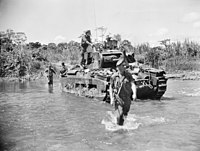15th Brigade (Australia)
| 15th Brigade (Australia) | |
|---|---|

Troops and Matilda tanks from the 15th Brigade cross the Hongorai River in May 1945
|
|
| Active | 1916–19 1921–45 |
| Country |
|
| Branch | Australian Army |
| Type | Infantry |
| Size | ~3,500 men |
| Part of |
5th Division (1916–19) 3rd Division (1921–45) |
| Engagements | |
| Commanders | |
| Notable commanders |
Harold Elliott Heathcote Hammer |
The 15th Brigade was an infantry brigade of the Australian Army. Originally raised in 1916 for service during World War I, the brigade took part in the fighting on the Western Front in France and Belgium before being disbanded in 1919. After this it was re-raised as a part-time unit of the Citizens Force in 1921 in Victoria. During World War II the brigade took part in the Salamaua–Lae and Bougainville campaigns before being disbanded following the end of hostilities.
The 15th Brigade was originally raised during World War I under the command of Brigadier General Harold Elliott as part of the expansion of the Australian Imperial Force (AIF) that was undertaken in 1916 following the conclusion of the Gallipoli campaign. Drawing a cadre of experienced personnel who had fought during the Gallipoli campaign from the 2nd Brigade, the brigade was assigned to the 5th Division upon formation and was made up of four infantry battalions—the 57th, 58th, 59th and 60th Battalions. Meanwhile, after July 1916 it also consisted of the following supporting elements: 15th Field Company Engineers, 15th Machine Gun Company, 15th Light Trench Mortar Battery and the 15th Field Ambulance. Following the 5th Division's arrival in Europe, the brigade's first major action came at Fromelles in July 1916 when they were committed to attacking the German positions along the Laies River which were held by the 16th Bavarian Reserve Infantry Regiment along with the British 184th Infantry Brigade. During the battle, two of the brigade's battalions—the 59th and 60th—were committed to the assault while the other two were held back in reserve. Of the two assault battalions, the 60th suffered the heaviest casualties, losing 16 officers and 741 men, while the 59th suffered 695 casualties.
...
Wikipedia
